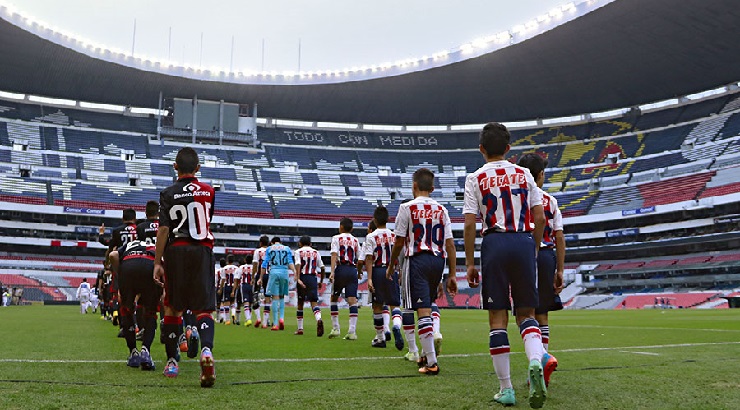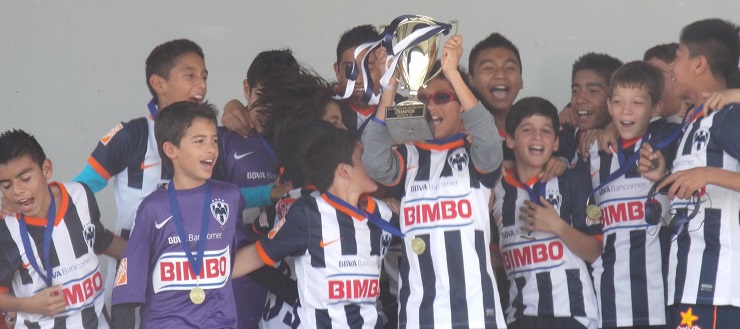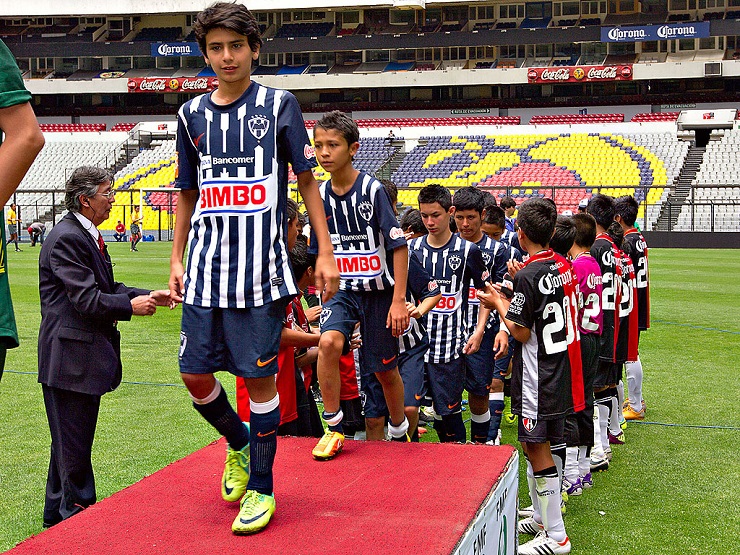Soccer News: Elite Player Development in Mexico
Current US Development Academy Scout for US Soccer, Scott Spencer is also the current tournament director for CF Monterrey Rayados and Copa Rayados Internacional, held in San Antonio, Texas. He has 17 years experience in American youth soccer including being the Alabama State Director of Coaching, a State and Regional ODP coach, a state and national coaching education instructor, as well as a youth soccer club director.
In addition to observing Mexican youth teams in Texas, Spencer lived in Monterrey, Mexico for two years and shares his perspective on Mexican youth soccer.
Mexico has been producing talented youth players for decades and continues to have success on a large scale. There are many components to this beyond the obvious – the national sport and the population base. I’ve been fortunate to observe numerous youth programs in Mexico from amateur to pro club academies to youth national teams over the past several years. For two years, I lived in Monterrey, Mexico, working on youth projects with CF Monterrey Rayados – one of the top pro clubs and youth academies in the country. Rayados regularly produces youth national team players for both Mexico and the United States.
My perspective is from experiences in American youth soccer. I grew up playing in suburbia and continued on collegiately and professionally in the US. For more than 15 years, I have been a fulltime youth soccer professional in a variety of roles including as a club DOC, State DOC, ODP coach, US Soccer scout, and a coaching education instructor. As a US representative for CF Monterrey Rayados and the tournament director for their international tournament in San Antonio, TX, the SeaWorld Copa Rayados Internacional, there is some good and some bad that the US youth soccer community can learn from our friends south of the border.
My first experiences with Mexican youth teams was with Region 3 ODP teams’ international trips to Guadalajara to play pro club academies. 10 years ago, the regional teams were the best of the best in the US, and we played the youth academies of Chivas, Tecos, and Atlas in Guadalajara. My first observations on this trip were:
– Every player was technical and comfortable on the ball and played out of the back consistently
– Every player competed 100% from the 1st minute on
– Some subs didn’t get in the game and if they did, they played as if their performance determined the next time they would play (which it did!)
 I remember my first visit to Valle Verde, Chivas’ famed training grounds, and watching a training session of Chivas’ under 11’s.
I remember my first visit to Valle Verde, Chivas’ famed training grounds, and watching a training session of Chivas’ under 11’s.
It was a tactical, functional training session. The focus was to link the backs with the midfield in build-up play from a goal kick, with the opposition pressuring using a 3 forward front. The outside back received the pass and was under immense pressure. The coach worked on support play, decision making, and technically solving the problems. Sometimes the team broke pressure and got to midfield under control, sometimes the team lost possession in a less dangerous location, and sometimes the team lost possession to the forwards who went 1v1 against the goalkeeper. At no point, did the players serve a long ball up the field or “clear” the ball. The coaches worked on what were the best choices and how to do better when things broke down. The players never had the mindset to abandon a possession build-up even when under pressure and losing possession.
For the development of a 9, 10, and 11 year old, what is the impact on these players in this environment?
 On training and the approach to training of players:
On training and the approach to training of players:
All the players are committed to being at training and while there’s a general time period for training – training ends when the coaches end training – maybe earlier or maybe later – mom is never hitting the horn, saying it’s time to go!
I remember once taking some of our top ODP players to train with the academy (fuerzas basicas) teams of Rayados several years ago. At one training session (2 hour session), the coach organized a penalty kick contest to see who the last player to miss would be. This lasted 45 minutes but no one seemed anxious to leave or tired of a 3 hour session. Afterwards, I spoke with the coach discussing the subject of long training sessions and burnout. His response: “This is the most enjoyable part of their day, they are with their friends, they love soccer, we are having fun… where else would they rather be?” Parents were waiting; but, there’s not a rush to get to piano lessons or the next scheduled activity.
On player development vs winning mentality:
There’s a common perception in the US that having a winning mentality (playing to win) is destroying player development in the US. But, I’ve never watched a Mexican academy team that didn’t have a true passion to win matches. Players and coaches would be upset if the team loses. I’ve seen players crying when losing games, even in a friendly tournament, that has no real consequence. I’ve seen coaches driving their players to perform and win matches without the “side point” of “we played better than the other team, so it’s ok”. They want to win, they have passion, and on average, it’s at a high level.
The difference is that they don’t sacrifice their style of play in the pursuit of winning. It’s a belief to play a technically sound, possession oriented style is the best method to both develop and win. They won’t go away from playing their style of soccer; but, will compete 100% to win this way. To believe that Americans want to win more than other nationalities is simply wrong. Too often, many of our youth teams sacrifice a style of play that is conducive to player development in our attempt to win.
 On a national culture of soccer:
On a national culture of soccer:
The Mexican Pro 1st division (Liga MX) is followed passionately with huge TV numbers. Kids from a very young age are around the game and a game that is generally played with an appreciation of skill and ball possession. The game is expected to be played a certain way.
I remember one time I was visiting CF Pachuca’s training facilities and they had youth summer camps going on- very similar to camps that would be in the US with kids registering for 1 week of instruction and play. I was watching the 5-6 year olds – certainly an age that has had little to no formal instruction, play, and experience. The kids were playing a 2 v 1 possession activity and the natural tendencies of the players were:
1) dribble / or shield when under pressure (not kick and run)
2) off ball player – move to get open (not to run to the ball and take it away)
3) not always; but, often- pass to the open teammate
There is nothing exceptional about these comments except for the ages of the players and that these players were random kids that signed up and paid for a week of camp. These were not the best of the best. They displayed instincts of skill and intelligence that will serve them well in their future development. This can only reasonable be explained as a product of their environment and probably some play with their father. Go and watch a “Beginner’s Camp” at your local park and there won’t be many 5-6 year olds with these traits. I can only assume that this is a product of being in a soccer culture with a certain national playing style.
This culture and passion for soccer has pros and cons as it relates to the top youth academy players. In most pro clubs, academy players are not required to complete their high school education. Many players drop out of High School at around age 15, if they are pursuing a professional career. Unfortunately, there is a mindset among many players that if you are going to school and pursuing soccer, you are not dedicating as much time as the players you are competing with.
Those that do attend high school, the school day is usually about 5 hours with limited homework, leaving more time in the day for soccer and free time. Considering only a few players from the Under 17 teams usually make it to the 1st teams, this is not great for the future and welfare of the player. Many are left without a high school education. Some will continue in the lower divisions of pro soccer and others won’t have that. The culture is changing slowly and I can proudly say that at Rayados, all players are required to complete their high school education. The club has arrangements with schools to coordinate their schedules and travel. Overall, the emphasis on education in the USA is great for the future of the players’ lives. Many middle to upper class families in Mexico don’t want their sons to join a pro academy as they want a greater focus on education. It can be balanced; but, it is not the norm.
 On the Mexican Federation and its role on youth development:
On the Mexican Federation and its role on youth development:
I’ve been impressed with the coordination that the Mexican federation has had with the professional clubs on youth development as it relates to the overall development for Mexico. There are various restrictions on youth foreign players that are very limiting. Pro clubs can have 1 or 2 players on their official Under 17 and Under 20 teams that are foreigners. Several can be signed to the actual pro teams; but, in their reserve and youth systems, it is fairly limited to developing domestic players.
The federation has regular council meetings with the representatives of all the LigaMX pro clubs about youth development issues. Several years ago, the structure of league play for these teams was playing in the 2nd, 3rd, or 4th divisions which created large discrepancies in the quality of the matches – both in terms of facilities and organization; as well as, competition. Working together, all 1st division teams now field an under 20 and under 17 team as their official reserve teams and follow the identical schedule as the 1st teams over the course of the year. Beginning in the fall (Apertura) of 2015, LigaMX clubs are adding Under 15 and a new Reserve league (players 20 to 25 years of age) to the same schedule. It standardizes the weekly and seasonal cycles for these age groups plus guaranteeing great competition for every match. This has come from both the federation and the professional clubs coordinating their efforts and mandating finances to their programs.
On Coaching Education:
The role of coaching education in the youth programs is an interesting one. To complete the program and be licensed to coach at the academy level in Mexico, requires a 2 year commitment. It is an extensive program requiring weekly classroom and field sessions for the 2 years. The level of coaching, for the most part, across the professional youth academies is quite good. Most of the coaches are former players that have then completed the coaching education licensing program.
There is a big drop to the amateur youth level – the community level. There are no licensing requirements for regular youth teams and there’s a great range from good to bad. At this level, there’s also a lack of age appropriate coaching occurring at a much higher rate than in the US. While youth coaching in the US needs to continue to grow in this area, the efforts of US Soccer, US Youth Soccer, and the NSCAA have certainly impacted the overall youth soccer coaching community in these areas at a much higher percentage than in Mexico.
 On having a large player pool:
On having a large player pool:
There is a very large player pool in Mexico, and in many countries. Everyone plays! Of course, in the USA, the percentage may be a little less; but, a lot of children play soccer and the USA has 3 times the population of Mexico. There are probably more kids playing soccer in the USA than in Mexico and most countries. A difference is probably the amount that most kids play. In Mexico, there are many recreation level teams that practice 2-4 times a week or a player plays on more than 1 team. This creates a larger player pool of talented players.
Monterrey Rayados just started a program to extend their academy teams to the Under 10-12 age groups. After having a month of tryouts in their “Rayados en la Mira”, 6000 players from the greater Monterrey area had tried out. The players that make these teams would be in the official academy with daily training for about 48 weeks out of the year. There are certainly plenty of players that don’t make the teams that are very good and provide a great pool of players to take someone’s spot if a team player isn’t performing. The large player pool helps breed a competitive environment.
On the structure of pro clubs’ academies:
The structures of pro club academies varies somewhat from club to club but there are some basic aspects in place. All pro clubs are required to have the Under 20 and Under 17 levels that play in the federation league. There is also official Under 15 and Under 13 levels; but, those play in regional leagues, usually against older players. At the academy level, all expenses are paid for by the club including soccer expenses, medical expenses, education, housing and meals if not from the area.
Below fuerzas basicas (academies), are the affiliated soccer schools of the club. These are more comparative to youth soccer clubs in the USA, though typically smaller programs of 4-20 teams. These soccer schools are affiliates of the club and fuerzas basicas and provide both a player base and scouting system. Most major pro clubs have 50-200 soccer schools scattered across Mexico with some in the USA. Soccer schools are pay to play models though typically at a modest level. Coaches are either volunteers or receive stipends. Very few coaches / directors of soccer schools are able to be fulltime -though there are some. Another layer of the pro club youth academy is a scouting and network system. Clubs will have fulltime scouts covering a region of the country primarily scouting for players 12-15 to sign. Clubs will typically employ 4-8 fulltime youth scouts to compliment open tryouts in the pursuit of new talent.
There are many interesting aspects of youth soccer development in Mexico. The strides in development in both the USA and Mexico have been great in the past 20 years and there are lessons to be learned on both sides of the border. The USA has been taking great strides forward in development with many MLS youth academies as great examples. Likewise, there are some great examples from Mexico – some to emulate, some to adjust, and some to avoid.
CF Monterrey Rayados now hosts the Copa Rayados Internacional in San Antonio TX where 300 teams from Mexico, USA, and the world come together for an international youth tournament unlike any other in either country. It’s an opportunity to compare, contrast, and compete with top youth teams from both sides of the border.






